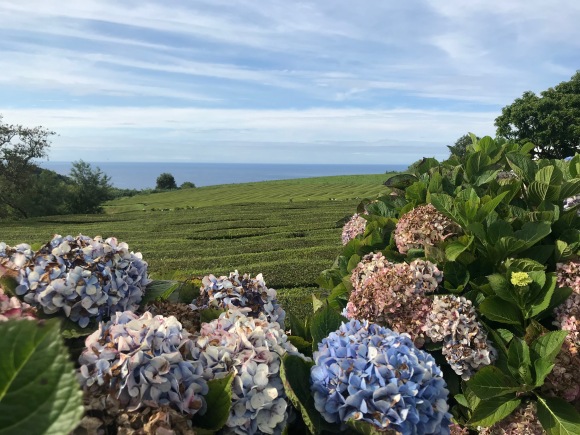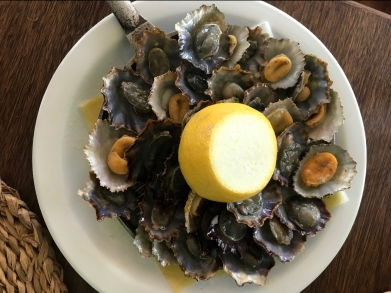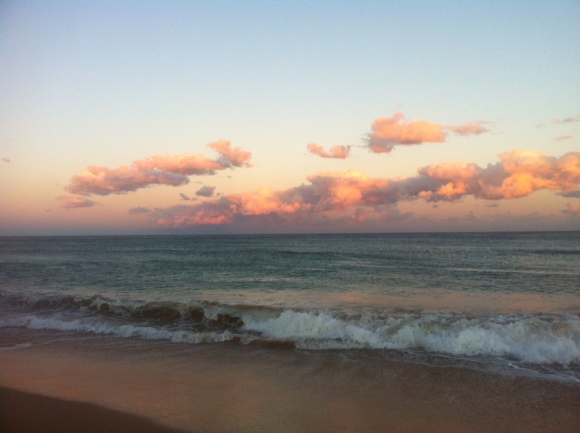On the island of Terceira, in the Portuguese island group known as the Azores, there’s an ancient volcanic ruin that now serves as a locals-recommended hotspot. Buses – filled with families and tour groups – drop guests off, their drivers dozing in the front seat while their charges make a circuit deep into the hollows of the volcano.
Algar do Carvão, which translates loosely to “a cavern of coal”, is almost 100 metres deep, with a wide mouth that frames the sky. It’s nestled high on a mountaintop, surrounded by Jurassic-feeling foliage and neighboured by a tiny cafe. At the mouth of the volcano, which is only visible when you have walked down a cold, echoey corridor underneath it, greenery spills – uncontainable and stretching towards the sunlight. A walk into the depths of the volcano is steep, and slippery, and footholds are not aided by patches of ferns peeking between rocks. The water that seeps out of the walls is cold, and the mossy growth on the seams in the rock is soft and squishy, earthly and visceral.

The view to the opening of Algar do Carvao. | Photo by R.
On our visit – which appeared to coincide with the visits of at least 100 other people, no small feat given we’d driven for stretches at a time without seeing other cars on our way to the site – the sky was blue. The past few days had seen rain clouds on a rather constant roll, a grey vista for a tropical area, the drizzly landscape punctuated only by blooming hydrangeas in pastel pinks and blues. (Writing now, it is not lost on me that we spent one of our few blue-skied afternoons underground. Such is the nature, if you will, of adventure.) Families, preparing to leave as we were arriving, briefly nursed piccolos and Donas Amelia (the raisin-studded pastries of the island) in the car park. Children squealed and chased each other among chunks of black lava stone fashioned as seats. This monolithic rock was a deeply exciting – and exceedingly accessible – place to be, and that was infectious.
There are nine separate islands that make up the Azorean archipelago. For our first journey, we visited just two: Terceira, home of volcanic fissures and the occasional bullfight, and São Miguel, the most populated and the site of the international airport. Our decision to visit the Azores was very much a spin-the-globe one; neither of us had heard of the island group before we booked our flights. That, in retrospect, was the perfect fit for what we both needed: a departure from the demands of full-time careers, a check-in with ourselves about what we wanted and needed from our daily life, and a reminder of the capacity of nature to restore our souls.

Hydrangeas were plentiful on the islands, peppering roads here, there and everywhere. | Photo by R.
The questions I found myself wrestling with before I departed to Portugal (which was part of a larger six-week trip that was otherwise US-based), centered around purpose: what do I want from my career? What do I want from my non-work life? How do I want to show up to the world? What kind of future do I want to create? A monotony of madness had made the answers to those questions unclear, and the speed of modern life had made processing them feel almost impossible. My mind had felt foggy, like the answer was a flicker of light on the end of a rather stubborn candle wick and the amount of focus to get it to spark into a flame was more than I could muster. Fitting, then, that we unconsciously and unintentionally managed to find a location that felt like it was slower, with communities coming together over a religious “festa” down main street and cafes where everyone knew each others’names (a cafe that was also, come nightfall, the bar).
We spent a week on the islands, meandering around, eating lots and lots of limpets (a small shelled mollusc with a coin-sized muscle, best served grilled or steamed and topped with garlic and parsley), and engaging with the natural environment. At one point, we stayed on a micro-farm and char-grilled flanks of a cow that had been raised on the grass in front of us.

A plate of limpets for dinner, an Azorean staple. Photo by R.
Originally, we had planned to visit many more natural sites on the islands, unwittingly thinking a ferry could potter us between them like a ferry on Sydney Harbour might deliver someone to Manly from the central business district. (This was not the case.) Our final itinerary was determined much more by the proximity of locations on a paper map, and how we were feeling on any given day. We didn’t see all of the mountains or look-outs, lakes or monuments we set out to see, but what we did see was powerful, and intentional, and perfect.
Like Algar do Carvão, which has patiently sat on a tiny island in the middle of the Atlantic ocean for thousands of years. Little feet, big feet, feet covered in hiking boots and feet loosely “protected” in flip-flops, hauled people up and down the rocky stairs. At one point, a small child called it quits, sitting on the step and sobbing about the climb (which is understandable when your legs are the length of a baguette). At certain points on the descent, where the volcano revealed sparkling stones or angular magnificence, the collecting crowd would pause and quieten. It felt natural, mutual.
It was quietest in the tomb-like basement, where – if you craned your neck enough to the left – a speck of the sunlight at the leafy mouth was distantly visible. A handful of those same eager tourists attempted to take photos of the pit’s lake, and they captured about as much as one who attempts to photograph a ghost. People who had asked their companions for photographs looked at the images with furrowed brows, confused, as they walked back up the steps. Often, they didn’t look at the obsidian-flecked walls they stood in front of in search of that souvenir shot.

There was no shortage of beautiful scenery on the islands. | Photo by R.
Which is a pity. Because if they had, they would have seen that in the darkest, deepest part of the volcano, uplit with unnaturally white light to compensate for the lack of any direct natural light, tiny green mosses grew. The astounding ability of Mother Nature to remind us – humans – of our infinite tininess, and of how much we have to learn about the world around us, was clear at the site of an over-2000-year-old volcano. It was a reminder of the slowness of progress, that rushing things is not how we came to be a part of this living, breathing planet. It was a reminder that decisions and answers don’t have to come in weeks or months, but can instead reveal themselves in seasons and cycles. And it was a reminder that wherever we go, there we are – consciously, bravely, boldly, kindly, or (by choice) not.
In the darkness of that ancient volcano, I felt a sense of bright wonderment. It was quiet, and so was my mind. The world felt bigger and yet closer; the scope of my intentions felt more grounded and accessible. In the reflective darkness of that subterranean lake, almost 100 metres underground, the water ran on, ebbing and flowing as nature provided.
In the darkness, little ferns and beetles held dominion – and in the darkness, there was growth.
R.



